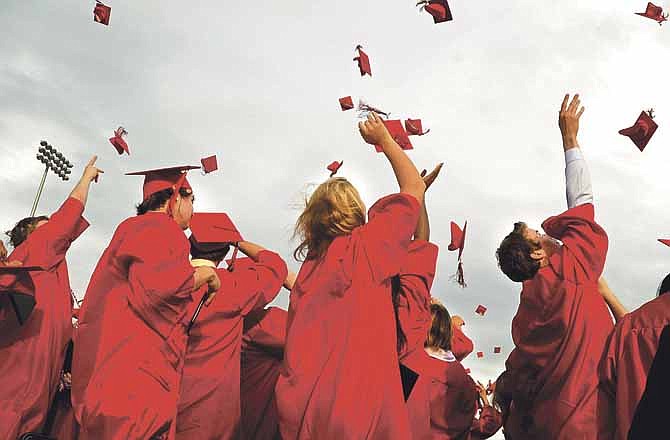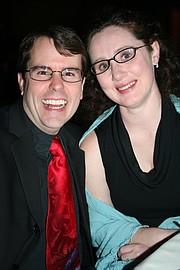In two weeks, hundreds of exuberant local teenagers will be walking across the stage at Adkins Stadium to accept the high school diplomas it took them years to earn.
But not all of their peers are going to make it.
In 2012, the graduation rate for the Jefferson City Public School district was 84.1 percent, slightly lower than the 86.07 percent statewide average.
In an effort to ensure more Jefferson City teens are earning degrees, administrators and faculty at Jefferson City High School are trying two fairly new strategies - Academic Labs and a Learning Center - to help them regain the footing, and the credits, they need to wear the cap and gown.
But Superintendent Brian Mitchell added boosting graduation rates really is a holistic approach that starts when students enter the schools.
"It's a pre-kindergarten through 12th-grade continuum of effort," he said.
Mitchell said the district's early education programming - such as Parents as Teachers and early childhood special education - are critical to preventing students from dropping out later in life.
"At the same time, there are very few resources provided for early childhood education," he lamented. "We are very limited in what we can provide."
Mitchell said educators also know literacy throughout all the grades is critical to students' success. Even math teachers and history teachers must be adept at helping students read in their content areas, he said.
"It's takes a shift in mindset, but all teachers are reading teachers," he said.
Mitchell also noted the district is working toward being able to collect and evaluate more academic data, so educators can respond more quickly to students' needs and so they aren't as reliant on high-stakes tests to determine how students are doing.
"There are a lot of things we're trying to do to build better relationships with students, so we can intervene and keep them in school," he said.
Why do JC's rates lag state average?
Debra Runzi, guidance director for the Jefferson City Public Schools, believes it might be partially due to the fact that Jefferson City serves a transient population.
"They (transient students) are at high risk of dropping out, and there's a chance of being lost in the shuffle," she said.
This year, more than 1,000 students moved into the district in the first through 12th grades, Mitchell said. The district has about 8,700 students.
Of those 1,000 students, 250 came from other states; 130 came from private institutions; 25 are from other countries and the rest transferred in from other Missouri public schools.
"One out of every nine students was new to us this year," he said. "That's pretty significant."
Since Labor Day, 145 new students were added to the roughly 2,670 students enrolled in the ninth through 12th grades, or a little more than 5 percent of the student population.
Mitchell said 40 percent of the district's dropouts transferred into the district after the eighth grade, he said.
Runzi noted Jefferson City is slated to earn all the available points in the next round of MSIP 5, the fifth incarnation of the Missouri School Improvement Program, designed to hold schools accountable.
Students leave school for many reasons. Sometimes their health is too fragile to attend every day. Just like adults, some suffer from mental health issues like anxiety and depression. Others stay at home to care for a sick parent.
Many times, students seek full-time employment so they can afford to move away from an unpleasant home life.
Some student groups still have challenges
In Jefferson City, students with disabilities have some of the lowest graduation rates; according to DESE, 66.2 percent of special-education students didn't earn diplomas in 2012.
Minorities lag behind white students; 87.4 percent of white students earn diplomas, compared with 71 percent of black students, 73 percent of Asian students, 75 percent of Limited English Proficient students and 85 percent of Hispanic students.
Two fairly obvious factors - a lack of attendance and the failure to pass classes - are correlated to a student's inability to earn a diploma.
Addressing those problems is where the JCHS guidance staff focuses its efforts.
"We always do have dropouts, but we continue to work with all students," she said.
Part of the counseling staff's responsibilities include examining the attendance data and identifying ways to help students.
Under Missouri law, teens can't leave school until they are 16 years old and have earned 16 credits of course work, which is effectively two years of school. Teens who turn 17 can leave without the 16 credits.
Fixing the problem
If Runzi had a magic wand and could change things, she would remove state rules that bind the district to a specified number of hours of attendance.
"I wish the state wouldn't bind up to minutes and hours of attendance," she said. "We want to be creative."
With a little more flexibility, Runzi thinks the school could schedule more beneficial internships and job shadowing programs for students. The school could also allow students to attend class at times that work better for them, such as in the late afternoon and evening.
She also wishes every student could ride the bus. Right now, students who live within five miles of the building must either find a ride or walk.
A group of local real estate agents - the group is called REACT, for Realtors Educating and Challenging Teens - have been helping with the latter problem. REACT also helps with mentors and picking up graduation and prom expenses.
"They purchase bus passes for us to give to kids," Runzi said. "There are some kids who would not be at school - they would be dropouts - if not for REACT."
"Academic Labs'
One intervention that the district is undertaking to help potential dropouts regain their academic footing and credits is the "Academic Labs" located around the building; the other is the "Learning Center" located on JCHS's third floor.
At the Academic Labs - held Tuesdays and Thursday mornings at both JCHS and Simonsen 9th Grade Center -Â students can drop in and get help from a knowledgeable teacher. During the collaboration time, students might not have access to their own teacher, but others from the same department will be available to assist.Â
As the flyer states, the goal is to "teach, inspire, motivate and empower."
Runzi said the 45-minute time blocks present "no obstacles" for student participation.
"You can still take the bus to school and grab breakfast," she noted.
She also noted the labs aren't intended only as a remedial effort. Students taking courses like trigonometry also are invited to participate.
It's the second year the Academic Labs are being implemented.
At the Learning Center, the school's educators are targeting at-risk sophomores who need to earn more credits for core courses like math and English.
"If they are failing, they'll be pulled out of an elective and put into the Learning Center," she explained. "Because you're not going to graduate with a bunch of electives."
"These are our two main pushes," Runzi said.
The district has also hired a "family school advocate" to help kids. Teshura Rogers has been working in that capacity for two years, Runzi said.
Rogers' goal is to make home visits and to help resolve the obstacles that keep sixth- through 12th-grade students from attending class.
Runzi said sometimes it's as simple as providing an embarrassed teen laundry soap or a lice kit so he or she can return to class. Other times, families need help identifying community resources to pay utility bills or find food.
The safety net has become more thready in the 10 years she's served the schools, and the tanking of the economy and the housing market hasn't helped parents keep jobs, she said.
At the high school today, 47 percent of all students qualify for free and reduced-price lunches.
JCAC enjoying fruits of its success
Now in its seventh year, JCAC is also another tool in the district's box to prevent kids from dropping out. The graduation rate for JCAC students is about 88 percent.
About 140 students attend class on the first and third floors of the Miller Performing Arts Center.
Students must interview with Principal Deanne Fischer to get in.
Kids who exhibit at-risk behaviors and have spotty attendance records are recognized by JCHS counselors as potential candidates, but to be accepted into the program they must convince Fischer they are ready to buckle down.
"This is an academic placement. It's a privileged environment, and students feel privileged to be here," she said. "There are more students on the wait list than enrolled."
Once they get in JCAC, old habits - like acting out, sleeping in class and failing to turn in their work - are expected to stop. It's part of the deal. In return, students benefit from smaller class sizes and more one-on-one instruction.
Although students are enrolled in the same kinds of classes they would find at the high school, they also work at computers - the program is called E2020 and it's accepted by the state - to recover credits they missed.
Math and literacy and the two primary stumbling blocks. Many of the students have behavioral issues, too. Every hour they miss, they have to make up.
"It makes them accountable for their attendance," she said.
To get through to students, the staff has used CharacterPlus education and Service Learning initiatives to show teens how to be successful and connect to the business community.
Senior Robert Taylor-Bey said he saw fighting with his teachers as a way to punish them.
"The main reason I failed ... I was never there. I didn't like the teachers, and I would not do the work," he said. "Even though it was only a detriment to myself."
At JCAC, Taylor-Bey said he feels he has more freedom to use his time wisely.
"I listen to my music, and I do my work, and I get so much done. It's so productive," he said. "I'm so glad I finally got to go to that school."
Fischer said she doesn't spend her day meting out discipline. Instead she prefers to talk conversationally with students to resolve conflict.
"We are developing the whole child. When you address those social and emotional issues, the academics are very easy," she said.
Accompanying photo: JCHS past graduation
Accompanying chart: Graduation and dropout rate comparison
Related article:


